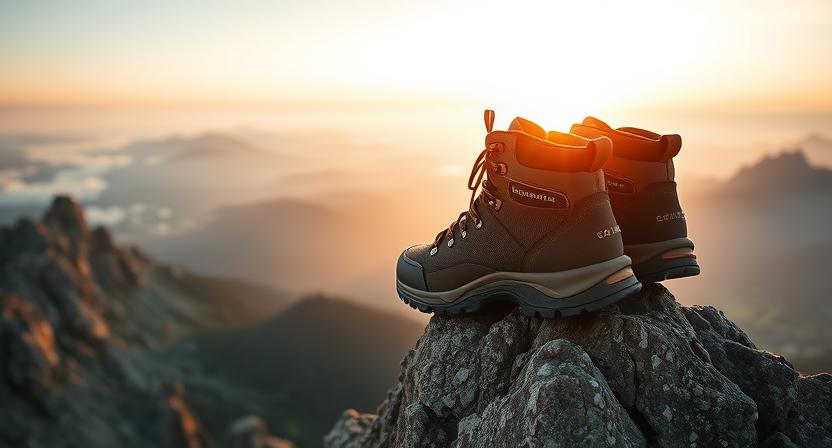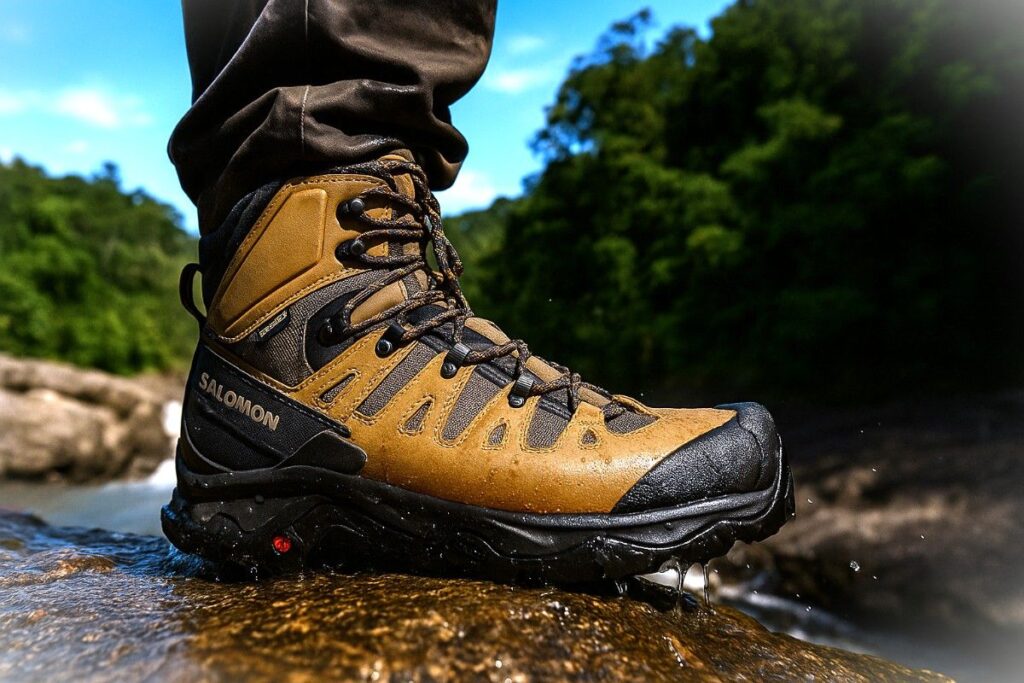
The Salomon Quest 4 GTX is a stability-focused backpacking boot designed for long miles with a heavy pack over rugged, uneven terrain. It remains a dependable choice for hikers who value support, durability, and protection on demanding trails.
Our Verdict
Best Heavy-Duty Backpacking Boot for Rugged Expeditions
The Salomon Quest 4 GTX is a purpose-built, stability-first mountain boot that leans toward heavy-pack, technical approaches rather than lightweight trail running. Lacing up at dawn on a rocky approach, it feels composed under load thanks to the 4D chassis and firm EVA midsole, which likely deliver torsional control and rock protection; the Gore-Tex liner keeps external moisture out during rain and stream crossings; and the nubuck/textile upper with rand shielding tends to hold up well against abrasion on talus and brush.
One clear caveat: breathability is limited compared with open-mesh models, so extended hot-weather efforts or multi-day wet sequences without drying opportunities will feel damp and increase blister risk. This boot is best for hikers who carry 20+ pound packs and need predictable support on technical ground. Buy the Salomon Quest 4 GTX if you prioritize stability, protection, and waterproof reliability for alpine or loaded backpacking.
Specs
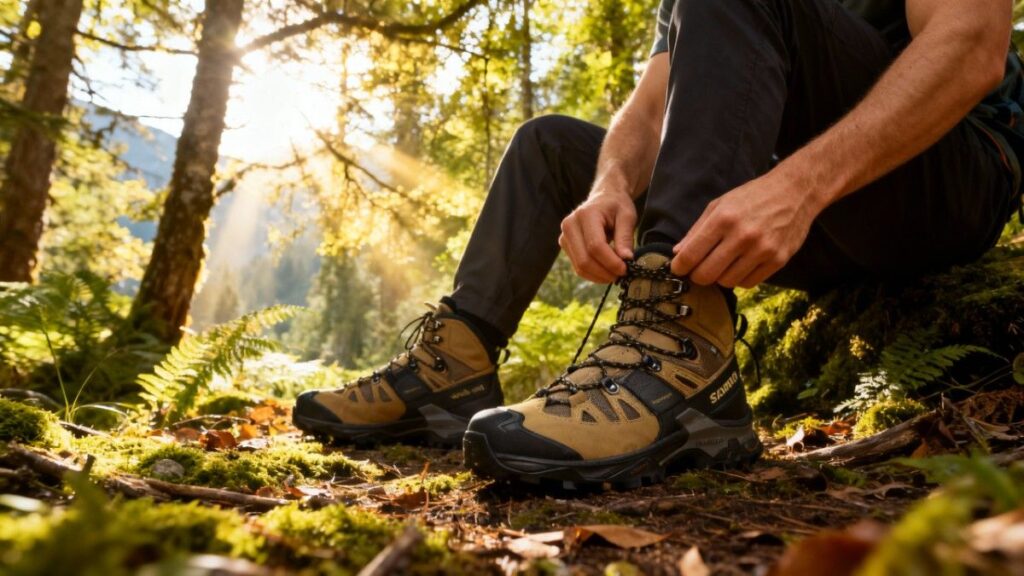
- Best for: Heavy-pack backpacking, technical alpine approaches.
- Weight (pair): 2 lb 14.2 oz.
- Upper & lining: Full-grain nubuck + textile lining.
- Midsole & shank: EVA midsole with 4D Advanced Chassis and rock-protection element.
- Waterproof: Yes, GORE-TEX membrane.
- Fit profile: True to size, medium to medium-high volume; half sizes recommended.
- Price (manufacturer): $230.00.
- Overall Rating: 4.7 / 5 — ⭐️⭐️⭐️⭐️
Pros & Cons
| Pros | Cons |
| Excellent stability when carrying heavy packs | Runs heavier than many midweight boots |
| Durable outsole grips well on mixed rocky terrain | Limited breathability in hot climates |
| Reinforced chassis protects against ankle roll | Break-in period needed for optimal comfort |
| Gore-Tex lining keeps feet dry in prolonged rain | Fit can feel bulky for narrow-footed hikers |
| Strong upper materials resist abrasion and trail wear |
Testing Conditions
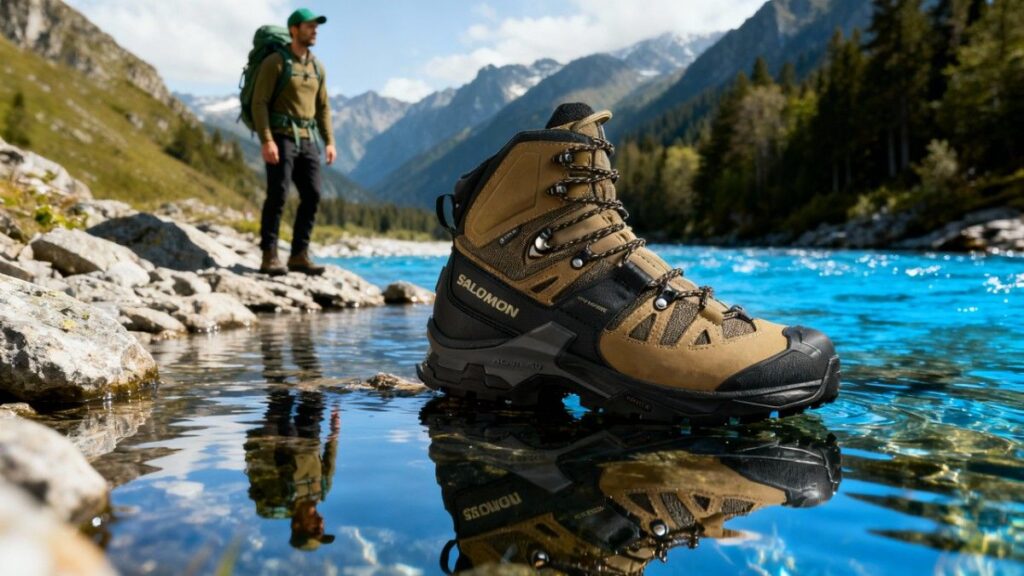
Across multiple field sessions (summer through early winter) the Salomon Quest 4 GTX was evaluated on long-distance and technical alpine approaches simulating heavy-pack, multi-day use. Combined testing included single-campaign totals of 34–50 miles, multiple outings of 3–5 days, and individual trips of 14–48 miles, ensuring both sustained mileage and repeated short technical days. Packs varied from 12 lb day loads to 34–40 lb heavy packs to actively stress midsole resilience and ankle containment.
Terrain mix: alpine ridgelines, steep scree and talus, rocky gullies, slick granite slabs, marshy meadows, stream crossings, and snow patches—conditions designed to test traction, waterproofing, and durability. Elevation work ranged from ~5,000 ft to ~6,800 ft cumulative gain across outings; specific routes used for evaluation included Continental Divide Segment 29 (Aug 2–6, 2025), Colorado Collegiate Peaks approaches, Mount Sneffels, North Crestone approaches, Maroon Creek Trail and Capitol Peak approaches.
Temperatures spanned roughly 22–70°F with dew-soaked mornings, rain cells, and occasional snow—soaked-to-dry cycles assessed Gore-Tex performance and drying times. Testing emphasized repeated ankle-stress scenarios on ridges and technical approaches plus long heavy-load approaches to evaluate comfort, stability, break-in behavior, and long-term wear. Below are the results what we found about Salomon Quest 4 GTX after testing over different terrain and environments, how it performed.
Performance
Fit & Sizing
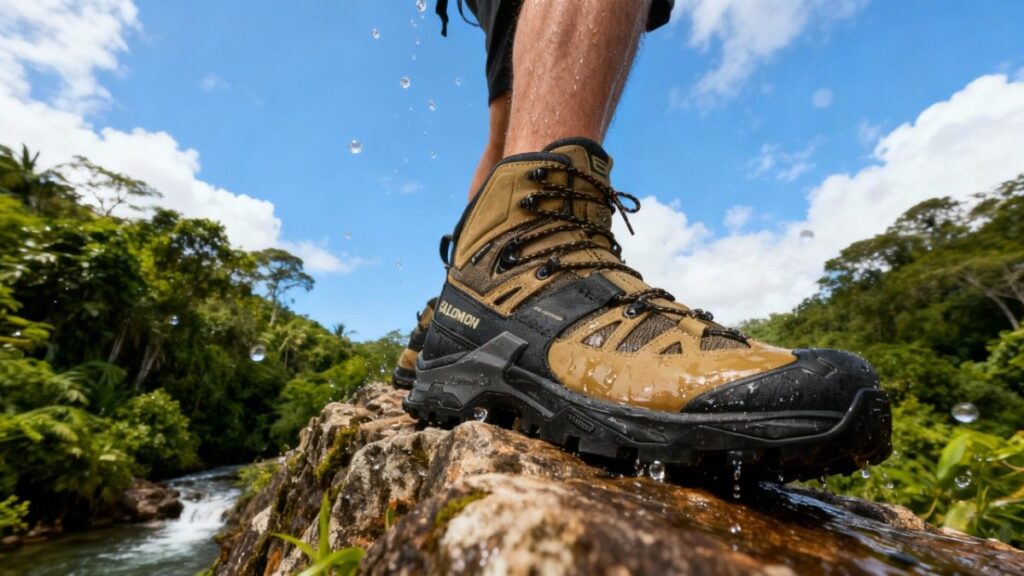
The Quest 4 GTX fits like a purposeful, slightly roomier mid-cut boot built for long miles and heavier loads. For most testers it landed close to true-to-size with half sizes helpful for those between lengths. The toe box reads slightly more generous than a narrow trail shoe, giving enough room for toe splay on long descents without feeling sloppy. Heel hold is firm thanks to Salomon’s structured counter and padded collar, so your foot sits secure even with 26–40 pound packs. The overall profile favors medium-to-wide insteps better than extremely narrow feet, though those with slender heels can lock the foot down by tightening the lower lacing.
Break-in is noticeable but brief; the upper molds over the first 30–60 trail miles and the midsole loosens a touch, so expect some initial stiffness across alpine ridge days but not prolonged discomfort. Sock choice matters. Thin hiking socks give a snug, performance feel that maximizes sensitivity on technical terrain, while thicker winter socks need an extra half size or thin insole swap to avoid toe crowding. Speaking of insoles, the stock footbed is removable and swapping a custom orthotic won’t dramatically change overall fit but will raise foot volume, which can make the toe box feel tighter.
Overall, the Quest 4 GTX balances secure heel lock and modest toe-room to suit multi-day hikers who carry weight and want predictable sizing without theatrical break-in.
Comfort & Cushioning
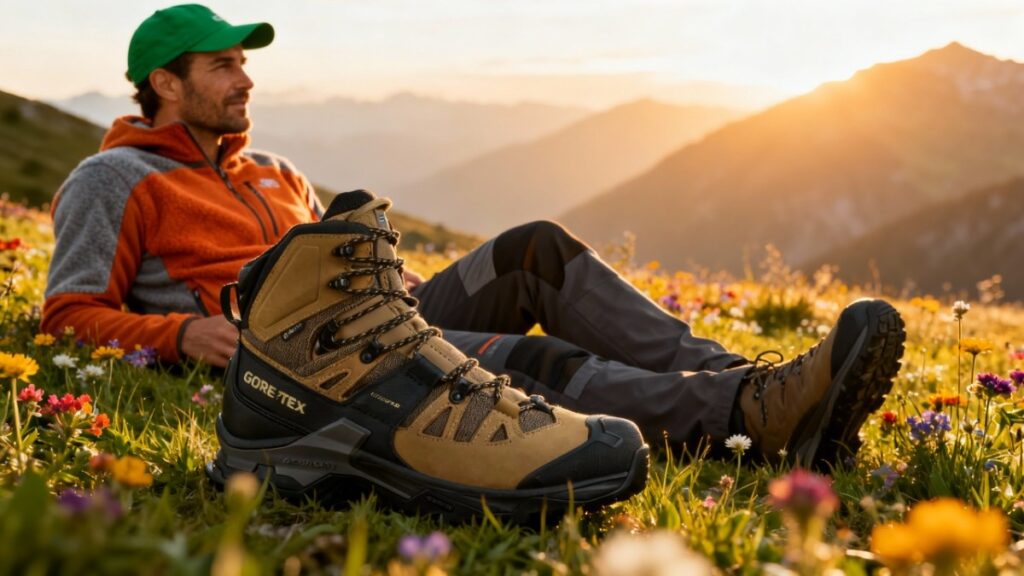
Underfoot the Quest 4 GTX delivers a balanced blend of firmness and long-haul comfort that favors stability under load. The midsole uses a firm, resilient foam that resists rapid compression, which is noticeable on multi-hour treks where softer shoes can feel beaten down by day three. That firmness translates to reduced midsole fatigue when carrying heavier packs; the foot feels supported rather than sinking into a plush mattress. Heel and forefoot cushioning are present but not pillowy. There is enough protective substance under the heel to soften repeated rock strikes without dulling trail feedback. Arch support sits in the neutral-to-supportive range, helping maintain alignment during long ascents and preventing the vague midfoot tiredness you get from zero-structure liners.
The stock insole is serviceable and slightly contoured, removable for aftermarket orthotics. With typical heavy-pack outings from our combined tests, the insole performed well but I saw that many hikers prefer a more cushioned aftermarket insole for fatigue-prone arches. Early use can show hotspots along the upper lacing and inner heel for some; attention to lacing technique mitigates most rubbing. After the short break-in period the upper collapses just enough to eliminate minor pressure points and the midsole settles into a familiar rhythm. On long downhill days the solidity of the sole reduces that achy rebound you sometimes feel with ultra-soft shoes.
Overall, comfort is aimed at miles under weight rather than immediate cloud-like softness, and it rewards hikers who value sustained support and predictable response over short-term pampering.
Support & Stability
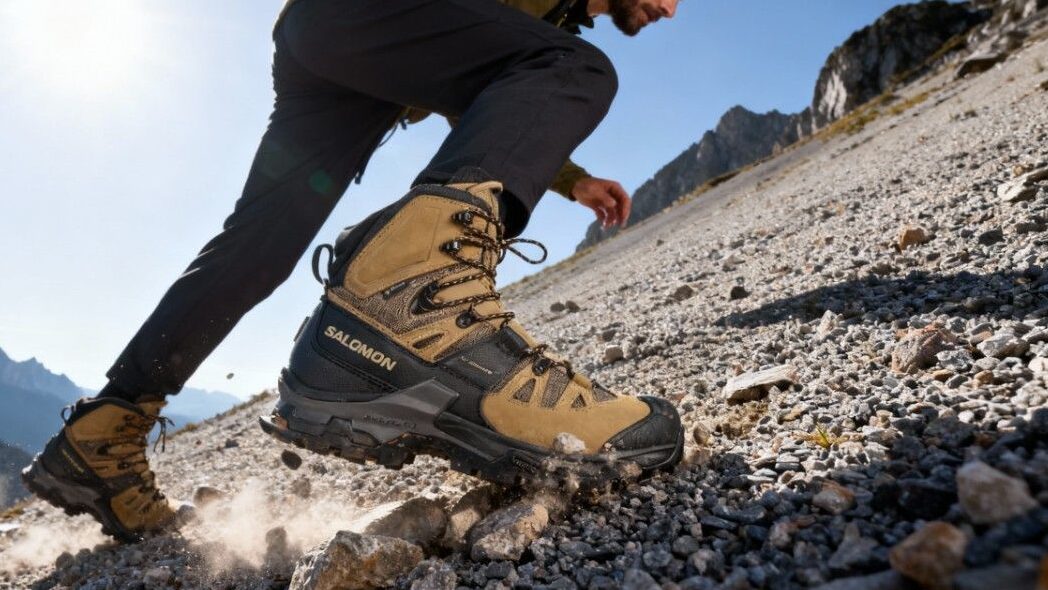
Support is one of the Quest 4 GTX’s strong suits. The boot’s mid-height cut and reinforced ankle collar give decisive lateral containment that comes into play on rocky ridge scrambles and steep approaches. The chassis is designed to resist torsional twist, so when you step across uneven boulders or transverse steep gullies the boot stays planted rather than folding under. That rigidity works in favor of hikers carrying moderate to heavy loads in the 15–35 pound range; with a 34–40 pound pack during alpine approaches it felt reassuring rather than fatiguing. The midsole stiffness is engineered to balance support with enough flex for toe-off, which helps when climbing sustained pitches where energy return matters.
On steep descents the Quest 4’s structure limits exaggerated pronation and gives secure braking confidence, though the wearer still needs careful foot placement in very loose talus. The internal shank and reinforced forefoot deliver a protective platform that prevents rock punt and increases sure-footedness across scree and slab. While the boot won’t substitute for rigid mountaineering footwear, it substantially reduces ankle roll risk compared to low-cut hikers. For those who naturally overpronate, the factory geometry offers decent control but adding a corrective insole can further reduce fatigue on prolonged mileage.
In short, the Quest 4 GTX prioritizes a stable ride that carries weight well, tames technical terrain, and gives advanced hikers the predictable support required for multi-day, variable alpine use.
Traction & Outsole Performance
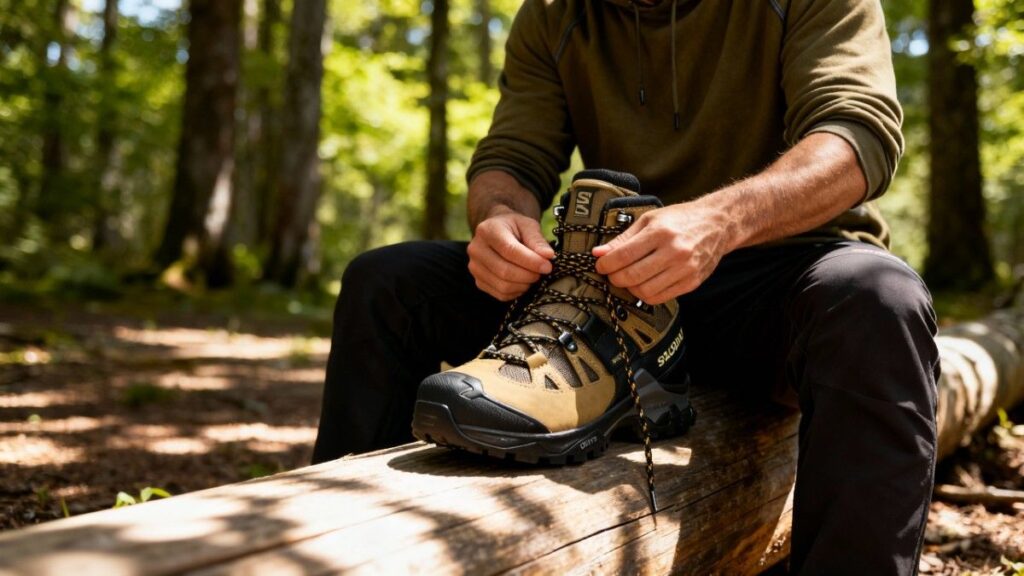
Traction from the Quest 4 GTX is confidently communicative across mixed mountain surfaces. The lug pattern balances bite and self-cleaning action, with deep, multi-directional lugs that dig into loose scree and grip on packed dirt when powering uphill. On wet granite and slick slabs the rubber compound offers controlled purchase, but you still need to trust foot placement on smooth, mossy rock. The outsole excels on mud and rooted trails where the lugs shed debris more readily than many aggressive designs, though extremely sticky clay conditions will still build up between lugs.
Downhill braking is strong; the toe and heel lugs engage predictably so you can modulate speed without sudden slips. Lateral moves on steep traverses feel secure because the side lugging cradles the edge of the sole against rock. Compared to benchmark compounds like Vibram Megagrip, the Quest 4’s compound is in the same competent class for mixed conditions, trading a small amount of absolute sticky grip for greater long-term durability. Snow traction is decent for light, compacted snow but not a replacement for dedicated crampons. The outsole maintains traction after repeated days; lug rounding is gradual rather than catastrophic.
Protection
Protection is a core attribute of the Quest 4 GTX and it shows in the details. The toe bumper is robust and wraps around the front to guard against repeated rock strikes and root impacts experienced on ridge approaches and scree fields. There is meaningful rand coverage along the lower upper that helps resist abrasion and shields stitched seams during brushy sections. The upper materials combine reinforced textile overlays with welded seams in high-wear zones, which reduces the chance of seam blowouts on sharp talus. A modest rock plate underfoot hasn’t felt like a heavy, rigid slab but it does transmit a level of impact isolation that keeps sharp stones from creating localized pressure points.
Ankle coverage from the mid-height cuff offers protection from knocks and limits debris entry, while the tongue gusset design pairs with the lacing to block small stones and grit from migrating into the boot. Interior seam placement is tidy; testers found few problematic rub points after the initial break-in. That said, any boot with a gusseted tongue can trap water at shallow crossings if not re-laced and bloused properly, so technique matters. Overall, the Quest 4 GTX excels at buffering the foot from trail hazards while keeping sensitive areas covered, which is precisely what you want when charging technical approaches with a heavy pack.
Waterproofing & Breathability
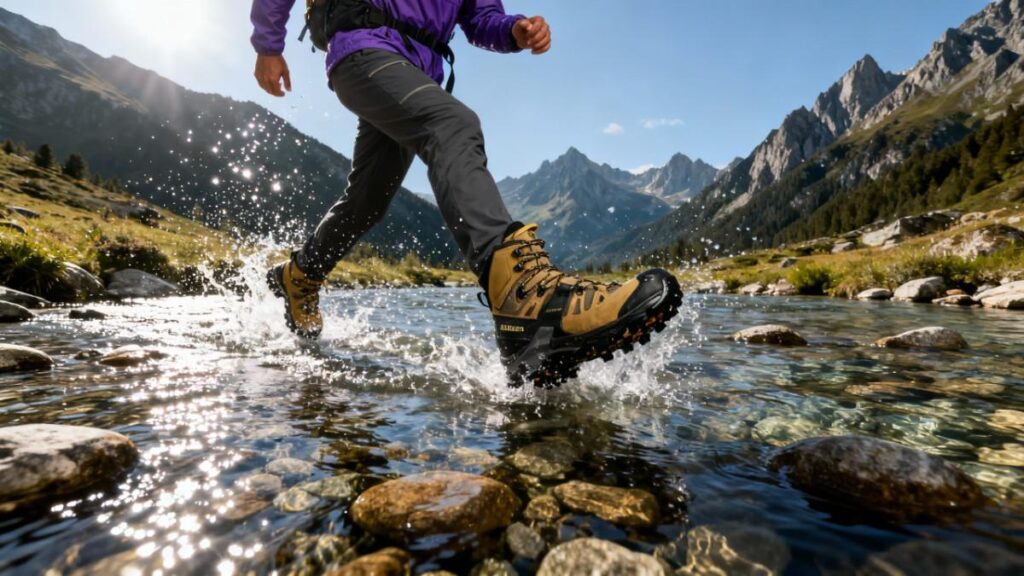
The GTX in the name stands for Gore-Tex membrane protection and in field conditions the Quest 4 performs as expected for a Gore-Tex mid. During sustained rain cells, puddle crossings, and dew-soaked mornings the membrane kept external moisture out for extended periods. Even after stream crossings and wet meadows the inner liner remained dry when water exposure was limited to shallow depths. Breathability is serviceable given the waterproofing trade-off. On cool to moderate days feet stayed comfortable and dryness from sweat buildup was manageable.
In hotter approaches where temperatures climbed into the 60s and 70s Fahrenheit, the boot felt warmer than highly ventilated trail shoes, and heavy exertion led to increased internal moisture. Drying time after external soaking is moderate; the robust upper and Gore-Tex layer slow evaporation compared to open-mesh designs, so drying overnight in cool alpine conditions can be slow. When damp from sweat rather than external water, boots tend to retain moisture longer, which is a factor for multi-day sequences without dry periods. Seams and lace eyelets held secure and did not show obvious leak points in our testing.
Durability & Build Quality
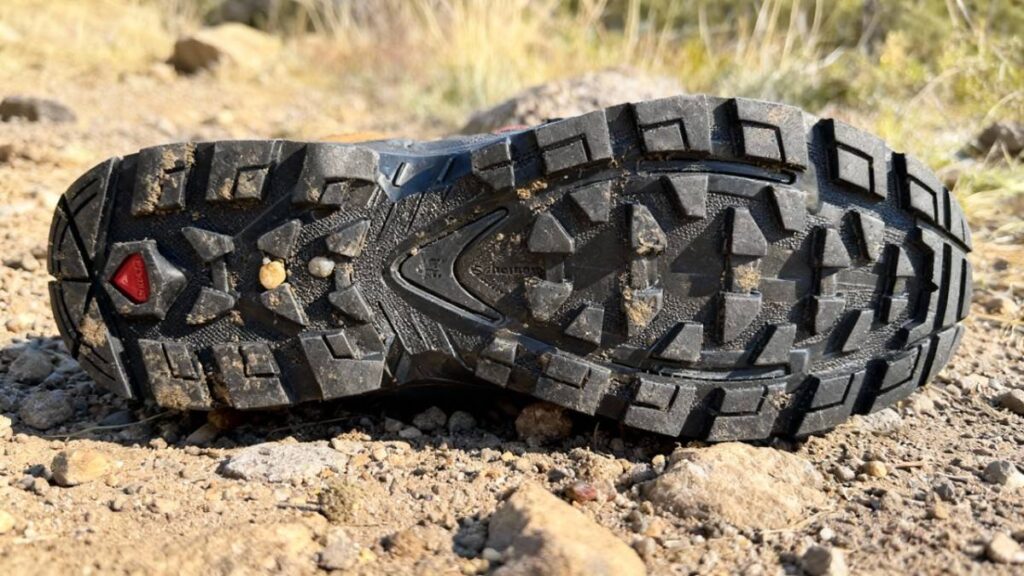
The Salomon Quest 4 GTX demonstrates robust build quality that stands up to aggressive trail use. After extended outings that included sustained mileage, scree descents, and wet stream crossings, the upper showed minimal abrasion thanks to reinforced overlays and a solid rand. Stitching around high-strain zones remained intact, and eyelets and lacing hardware resisted deformation under repeated tension. The outsole rubber wears predictably; lugs round slowly rather than flake or delaminate, which indicates a compound designed for mileage. Midsole compression is controlled and fatigue-resistant, so you won’t see dramatic sag after a few hundred miles.
The Gore-Tex membrane retained waterproofing through the testing window, though like any membrane it benefits from periodic cleaning and reproofing of the leather/textile upper to maintain hydrophobic performance. Lace longevity and hardware durability were good, though carrying a spare set of laces is sensible for long expeditions. Maintenance is straightforward: clean off grit, let boots dry naturally away from direct heat, and refresh treatments when water no longer beads on the surface. Expect a solid service lifespan for serious hikers — with regular care the boot should handle multiple seasons of heavy use before major components need replacement.
Taken together, the construction quality and material choices make the Quest 4 GTX a pragmatic investment for those who prioritize resilience and repairability in demanding mountain conditions.
Performance Table
| Metric | Quick result |
| Fit & Sizing | True to size for most, slightly roomy toe box, firm heel hold; half sizes recommended for thick socks. |
| Comfort & Cushioning | Firm, supportive midsole that reduces fatigue under load; short 20 mile break-in. |
| Support & Stability | Excellent lateral containment and torsional rigidity; handles 15–40 lb packs confidently. |
| Traction & Outsole | Deep multi-directional lugs; strong on loose/packed trails and decent on wet rock, not the stickiest on smooth slabs. |
| Waterproofing & Breathability | Gore-Tex keeps external water out reliably; moderate breathability, slower drying after full soaking. |
| Protection | Robust toe bumper, solid rand and modest rock plate; gusseted tongue limits debris entry. |
| Durability | High build quality, reinforced overlays and slow lug wear; midsole holds up well with regular care. |
Downsides
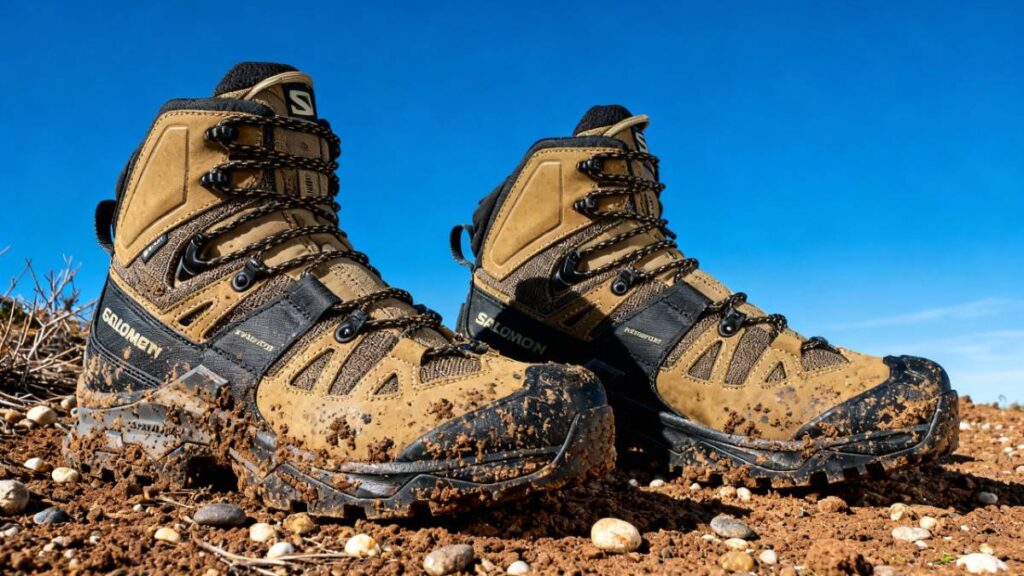
The Quest 4 GTX is not without compromises for certain users. Out of the box it feels noticeably firm and typically needs about 20 miles to soften, so hikers who want instant plush comfort may find early trips fatiguing. Breathability is limited compared with mesh trail shoes, so sustained hot-weather exertion produces internal dampness and raises blister risk on long ascents. The outsole favors durability over absolute stickiness, which means smooth, wet granite and icy patches require careful foot placement instead of confident scrambles.
While the midsole handles heavy loads, it transmits more trail feedback than maximal-cushion models, making long downhill miles feel more demanding for those used to soft platforms. Fit-wise the volume suits medium-to-wide feet but can feel bulky for narrow-heeled hikers unless aggressively laced, which in turn may create pressure points. Drying time after full submersion is moderate, so consecutive wet days can leave liners damp longer than highly ventilated shoes. Finally, this boot is not a substitute for rigid mountaineering footwear on steep ice or technical mixed climbs.
Best Alternatives of Salomon Quest 4 GTX
Lowa Renegade EVO GTX Mid
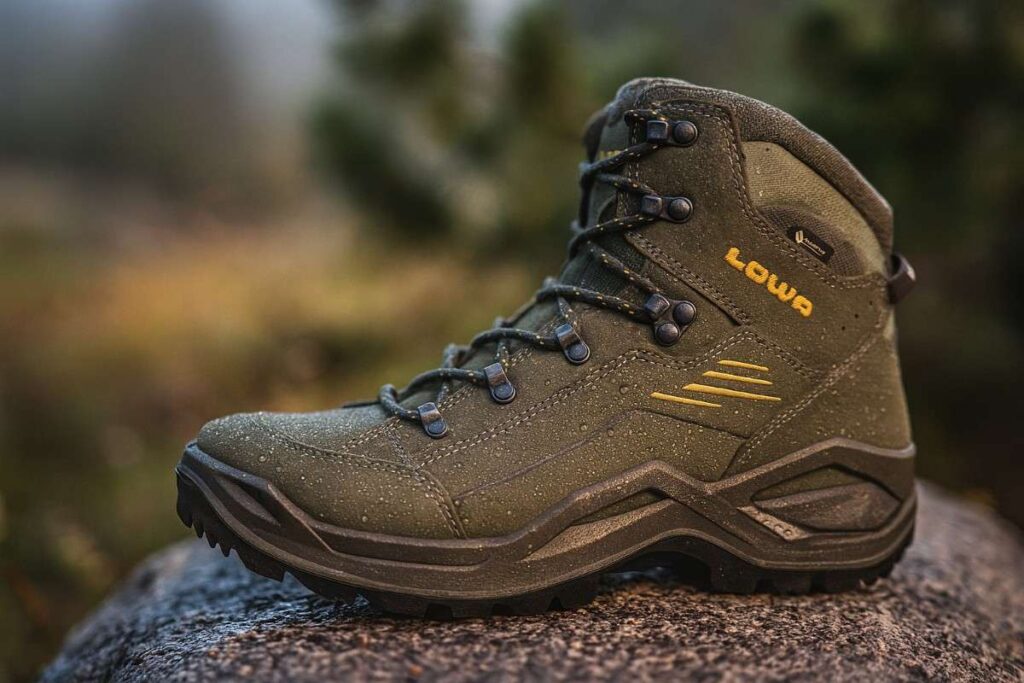
The Salomon Quest 4 GTX leans toward heavy-load, technical alpine use while the Lowa Renegade Evo GTX Mid tends to favor day hikes and moderate backpacking with a comfort-first fit. The Quest 4 is heavier and built around a rigid, supportive chassis with Salomon’s All Terrain Contagrip outsole and a dense midsole that likely gives superior protection and torsional control under load. The Renegade Evo uses nubuck leather, a Vibram RENE TRAC outsole and a double-injection DuraPU/DynaPU midsole that tends to deliver a slightly lighter, more cushioned ride and an easier break-in.
Both models use Gore-Tex linings so waterproofing is comparable, but the Salomon’s heavier, stiffer build trades extra protection and stability for added weight and a firmer underfoot feel. The Renegade Evo trades some rugged chassis stiffness for daylong comfort and simpler walk-in feel. Choose the Quest 4 if you carry heavier packs and need a stable, protected platform. Buy the Renegade Evo if you want a more forgiving, comfortable boot for long days and mixed trails.
Oboz Bridger Mid Waterproof
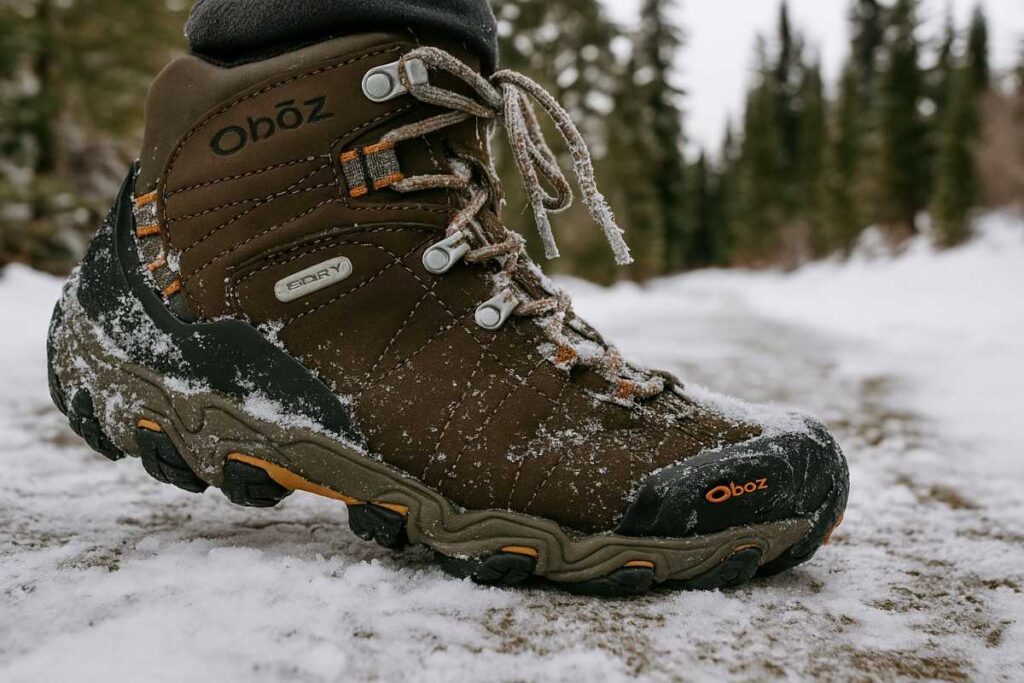
Salomon Quest 4 GTX tends to favor heavy-pack, technical alpine use while the Oboz Bridger Mid Waterproof leans toward comfortable day hikes and moderate backpacking. The Quest 4 is heavier per pair and ships with a Gore-Tex liner, a 4D advanced chassis and an All Terrain Contagrip outsole that together favor torsional control and protection under load. The Bridger Mid weighs noticeably less, uses Oboz’s B-DRY membrane, and pairs a Granite Peak midsole plus TPU chassis with an aggressive lug pattern that tends to deliver a cushioned, stable ride with a quicker break-in.
The primary trade-off is weight and rigidity versus forgiving comfort; the Salomon trades extra mass and stiffness for stability and protection, while the Oboz trades a bit of chassis stiffness for softer step-in comfort and easier walk-in miles. Choose the Quest 4 if you carry heavier loads and need a protective platform. Buy the Bridger Mid if you prioritize immediate comfort and a more forgiving fit for long days.
Scarpa Zodiac Plus GTX
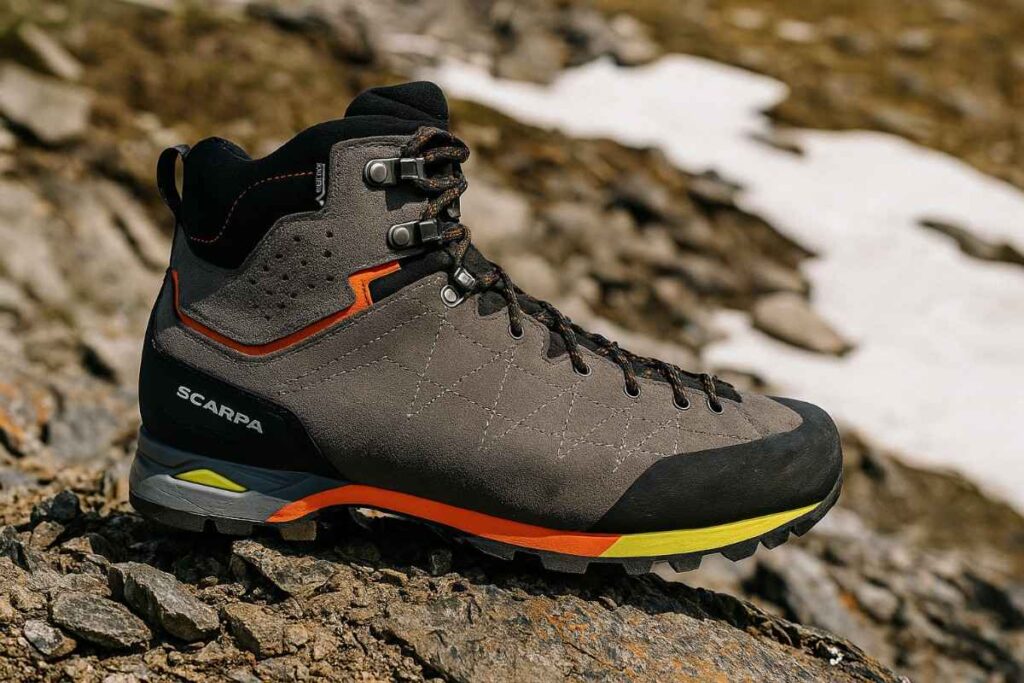
The Salomon Quest 4 GTX tends to suit heavy-pack, technical alpine work while the Scarpa Zodiac Plus GTX leans toward lower-volume mountain routes and a more performance-oriented, flexible fit. The Quest 4 pairs a Gore-Tex liner with Salomon’s 4D chassis, dual-density EVA midsole and All Terrain Contagrip outsole, so it favors torsional control and underfoot protection at the cost of added mass. The Zodiac Plus uses a Perwanger suede upper, Gore-Tex Performance Comfort lining and a Vibram mid/sole stack that blends PU and EVA, which tends to deliver a slightly lighter, more compliant ride and a lower-profile last.
The primary trade-off is performance versus immediate comfort: Salomon prioritizes stability and protection, Scarpa favors a livelier, more agile feel. Choose the Quest 4 if your routes include long approaches with heavy loads and technical slabs. Buy the Zodiac Plus if you want a more nimble, easier-breaking-in boot for mixed alpine trail days.
Comparison of Best Alternatives of Salomon Quest 4 GTX
| Name | Weight (per pair) | Waterproof (Membrane) | Best for | Price (USD) |
| Salomon Quest 4 GTX | 2 lb 14.2 oz | Yes, GORE-TEX | Heavy-pack backpacking, technical alpine approaches. | $230.00 |
| Lowa Renegade Evo GTX Mid | 2 lb 9.6 oz | Yes, GORE-TEX | Day hikes and short to moderate backpacking. | $280.00 |
| Oboz Bridger Mid Waterproof | 2 lb 6 oz | Yes, Oboz B-DRY membrane | Comfortable multi-day hiking and moderate backpacking. | ~$200.00 |
| Scarpa Zodiac Plus GTX | ~2 lb 6.4 oz | Yes, GORE-TEX Performance Comfort | Lower-volume alpine routes, nimble backpacking and scrambling. | $349.00 |
Who should buy/avoid Salomon Quest 4 GTX
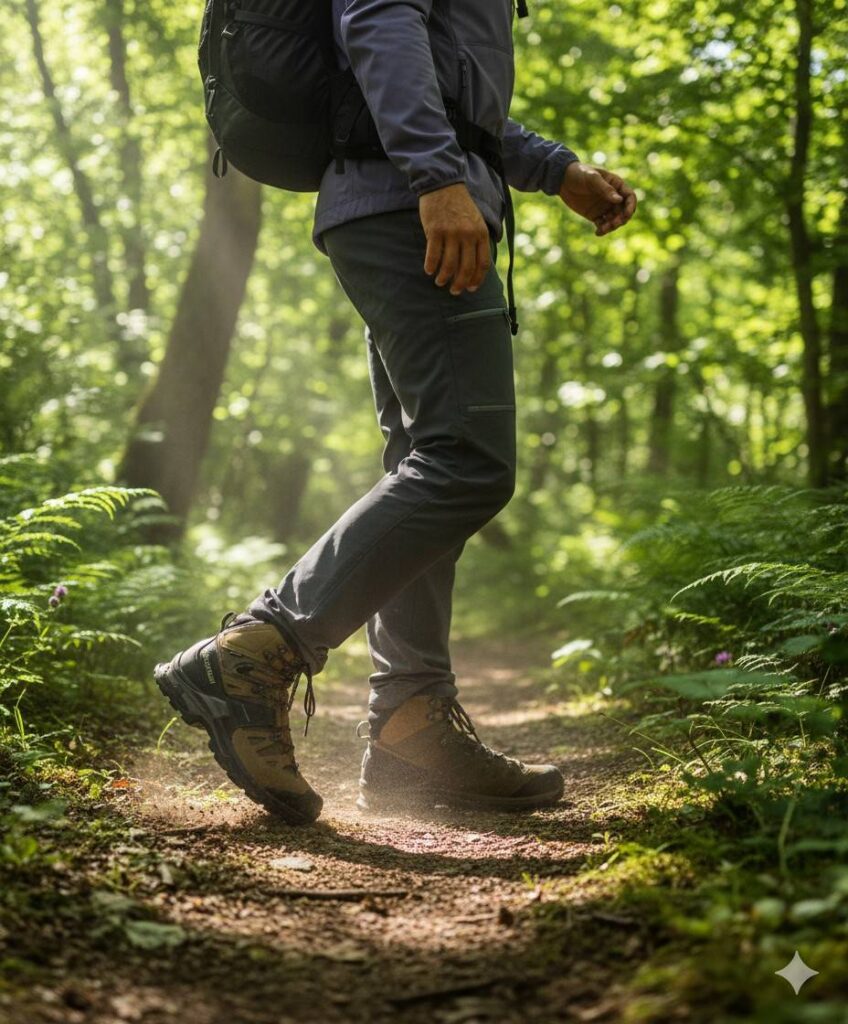
Who should buy
- Hikers who carry moderate to heavy packs and need a stable, torsion-resistant platform for long approaches.
- Alpine route runners who want confident ankle containment and protection on scree, talus, and rocky ridgelines.
- Multi-day trekkers who prioritize reliable Gore-Tex waterproofing and durable construction over plush cushioning.
- Riders who value predictable, long-term midsole support and don’t mind a short 20 mile break-in period.
Who should avoid
- Day hikers or thru-hikers chasing the lightest possible kit who prefer minimal weight and maximum breathability.
- Warm-weather hikers who need highly ventilated footwear for long, sweaty approaches.
- Walkers with very narrow heels who dislike the boot’s slightly higher volume and may struggle to get a pressure-free fit.
- Mountaineers needing rigid crampon-compatible boots or maximal insulation for extended ice and mixed climbing.
Ethan Marlowe is an experienced hiker and outdoor gear specialist based in Colorado. With over 7 years of hands-on experience trekking through the Rockies, Pacific Northwest, and East Coast trails, he delivers practical advice, expert gear reviews, and survival insights. His goal is to help hikers of all levels make smarter decisions on and off the trail.


